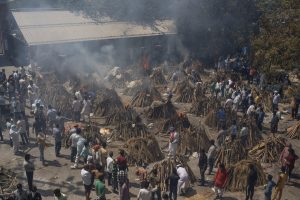Almost two years and three waves of the COVID-19 pandemic later, India has finally admitted that the coronavirus is in “community transmission” in the country.
“Omicron is now in community transmission in India and has become dominant in multiple metros, where new cases have been rising exponentially,” INSACOG, the consortium of national laboratories that is tracking the different variants of the coronavirus, said in its January 10 bulletin, which was made public only on January 23.
This is the first time that a government body has admitted to the reality on the ground. Hitherto, officials would simply deny that the pandemic was in the community transmission stage.
The closest the government came to admitting to community transmission was in October 2020 when the then-Union Minister for Health Harsh Vardhan said that “In different pockets across various states, including West Bengal, community transmission is expected to occur, especially in dense areas.” Denying that community transmission was happening across the country, Vardhan said that “It is limited only to certain districts and states.”
West Bengal is ruled by the opposition Trinamool Congress.
However, experts had been pointing to community transmission in India since the early months of the pandemic. Noted virologist and former professor of virology in the Christian Medical College in Vellore, Dr. T. Jacob John claimed that community transmission began around mid-March. “In my view, the Tamil Nadu case, detected on March 18, [2020] points out the community transmission,” John said in an interview in May that year. The Tamil Nadu case related 20-year-old man with no travel history abroad or contact with people from abroad. The man tested positive on March 18, 2020 after travelling by train from Delhi to Chennai.
Community transmission refers to the wide spreading of a virus in a population group. It becomes difficult, even impossible, to establish the chain of infections in such cases.
Instead of listing itself as a country in community transmission as have several countries, including the U.S., Brazil, and France, India put itself in a category indicating a less severe pandemic. It listed itself as a country dealing with several cluster outbreaks.
Anxious to convince Indians and the world that it was in control of the pandemic situation in the country, the Modi government chose to downplay the magnitude of the crisis.
Of course, this isn’t the only pandemic related issue where the government chose disingenuousness over transparency. It has grossly diminished the number of COVID-19 related fatalities, too.
Government figures put the number of COVID-19 deaths recorded between June 2020 and July 2021 at 419,000. However a study published in the journal Science on January 7, 2022 reported a “substantially greater” number of fatalities. The study estimated that around 3.2 million died due to the disease in that period.
Since the outbreak of the pandemic, the Modi government has often touted India’s low fatality rate as an achievement. “India is amongst the countries with least deaths due to coronavirus,” Modi said in a video conference with chief ministers in June 2020.
The under-reporting of deaths was “because of incomplete certification of COVID deaths and misattribution to chronic diseases and because most deaths occur in rural areas, often without medical attention.” the study says.
As per the government fatality figures, India ranked 105 of 201 countries as of July 3, 2021. If the study’s estimate of 3.2 million COVID deaths is correct, it means that 2,300 to 2,500 people per million had died from Covid-19 in India by July 31, 2021.
This would put India among the top 15 countries with regard to the highest Covid-19 death rate.
At the height of the second wave last year, a shortage of oxygen, hospital beds and ambulances resulted in hundreds of patients dying in hospital corridors and roads. People were dying in numbers that crematoriums and burial grounds couldn’t handle, forcing grieving families to burn bodies in parks and stadiums in New Delhi, the national capital. In Uttar Pradesh, desperate people were throwing corpses into rivers, which were subsequently washed ashore.
Pro-government media accused the few journalists and media houses who turned the spotlight on soaring fatalities of indulging in “vulture journalism.”
Interestingly, the number of families given financial compensation for losing kin to COVID far exceeds the government figures of the fatalities.
According to Gujarat’s health department figures, the state registered 10,098 deaths due to COVID. However, it was reported in December 2021 that 34,678 people had applied for compensation and the government had made payments to over 19,000 persons.
Clearly, it is hard to keep skeletons and secrets locked up for long.
The Modi government’s denial of the severity of the COVID-19 crisis in the country and its gross mishandling may have helped control damage to its image for a while. But denial of the gravity of the crisis will not make the problem go away.

































